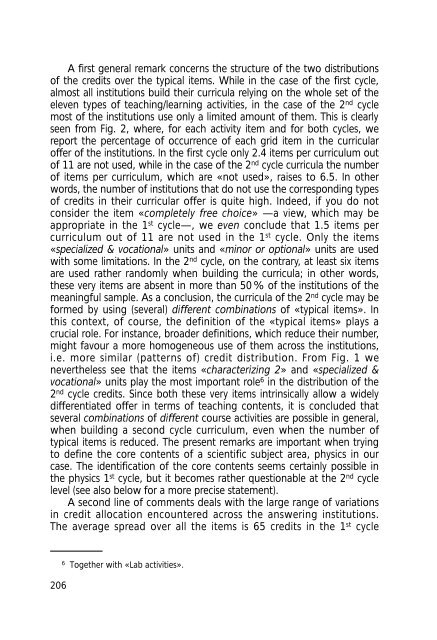Final Report Pilot Project - Relaciones Internacionales de la ...
Final Report Pilot Project - Relaciones Internacionales de la ...
Final Report Pilot Project - Relaciones Internacionales de la ...
You also want an ePaper? Increase the reach of your titles
YUMPU automatically turns print PDFs into web optimized ePapers that Google loves.
A first general remark concerns the structure of the two distributions<br />
of the credits over the typical items. While in the case of the first cycle,<br />
almost all institutions build their curricu<strong>la</strong> relying on the whole set of the<br />
eleven types of teaching/learning activities, in the case of the 2 nd cycle<br />
most of the institutions use only a limited amount of them. This is clearly<br />
seen from Fig. 2, where, for each activity item and for both cycles, we<br />
report the percentage of occurrence of each grid item in the curricu<strong>la</strong>r<br />
offer of the institutions. In the first cycle only 2.4 items per curriculum out<br />
of 11 are not used, while in the case of the 2 nd cycle curricu<strong>la</strong> the number<br />
of items per curriculum, which are «not used», raises to 6.5. In other<br />
words, the number of institutions that do not use the corresponding types<br />
of credits in their curricu<strong>la</strong>r offer is quite high. In<strong>de</strong>ed, if you do not<br />
consi<strong>de</strong>r the item «completely free choice» —a view, which may be<br />
appropriate in the 1 st cycle—, we even conclu<strong>de</strong> that 1.5 items per<br />
curriculum out of 11 are not used in the 1 st cycle. Only the items<br />
«specialized & vocational» units and «minor or optional» units are used<br />
with some limitations. In the 2 nd cycle, on the contrary, at least six items<br />
are used rather randomly when building the curricu<strong>la</strong>; in other words,<br />
these very items are absent in more than 50 % of the institutions of the<br />
meaningful sample. As a conclusion, the curricu<strong>la</strong> of the 2 nd cycle may be<br />
formed by using (several) different combinations of «typical items». In<br />
this context, of course, the <strong>de</strong>finition of the «typical items» p<strong>la</strong>ys a<br />
crucial role. For instance, broa<strong>de</strong>r <strong>de</strong>finitions, which reduce their number,<br />
might favour a more homogeneous use of them across the institutions,<br />
i.e. more simi<strong>la</strong>r (patterns of) credit distribution. From Fig. 1 we<br />
nevertheless see that the items «characterizing 2» and «specialized &<br />
vocational» units p<strong>la</strong>y the most important role 6 in the distribution of the<br />
2 nd cycle credits. Since both these very items intrinsically allow a wi<strong>de</strong>ly<br />
differentiated offer in terms of teaching contents, it is conclu<strong>de</strong>d that<br />
several combinations of different course activities are possible in general,<br />
when building a second cycle curriculum, even when the number of<br />
typical items is reduced. The present remarks are important when trying<br />
to <strong>de</strong>fine the core contents of a scientific subject area, physics in our<br />
case. The i<strong>de</strong>ntification of the core contents seems certainly possible in<br />
the physics 1 st cycle, but it becomes rather questionable at the 2 nd cycle<br />
level (see also below for a more precise statement).<br />
A second line of comments <strong>de</strong>als with the <strong>la</strong>rge range of variations<br />
in credit allocation encountered across the answering institutions.<br />
The average spread over all the items is 65 credits in the 1 st cycle<br />
206<br />
6 Together with «Lab activities».


